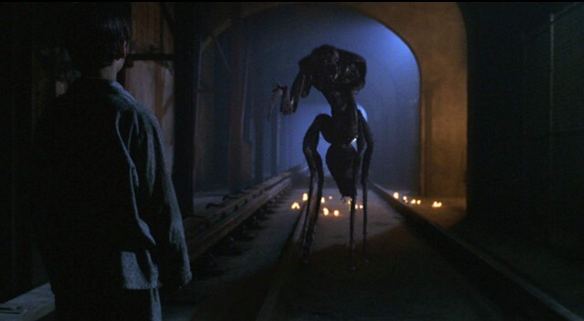Hello folks, and welcome back to Wrong Every Time. This week I have finally finished up Death Stranding 2, after spending far too many of my precious, fleeting hours trudging through snow and putting materials in boxes and receiving different materials to put in different boxes. I jest, but to be honest Kojima has got this gameplay loop down at this point, and has successfully merged Death Stranding’s mechanical fundamentals with a functional, Metal Gear-reminiscent combat system. The game is nowhere near as finicky or austere as its predecessor, which frankly left me with mixed feelings – Death Stranding 2 is a much more consistently dopamine-depositing game than its predecessor, but far less of an emotionally challenging, potentially transformative art experience. And considering the gaming industry is full of column A and sorely lacking in column B, it feels a little sad that one of our few reliable auteurs “just” made a solid videogame.
Anyway, I still quite enjoyed it, and will undoubtedly be returning to the roads of Australia for one of my final segments of these games: enjoying the fruits of my infrastructure work, riding the highways that now extend all the way across the continent. In the meantime, let’s break down the week in films!
First up this week was Mimic, a ‘97 creature feature directed by Guillermo del Toro. In order to combat the spread of disease-carrying cockroaches in Manhattan, two scientists develop the “Judas breed,” a hybrid insect designed to release chemicals that raise the cockroaches’ metabolism to the point of self-destruction. Three years later, it would appear their creation has not just survived, but undergone some evolution of its own, and now threatens to infiltrate, consume, and replace the people of New York City.
Mimic is an interesting artifact of a specific era in del Toro’s career, when he was juggling acclaimed projects in two languages, but had yet to acquire the prestige and resultant creative control Pan’s Labyrinth would earn him. As a result, Mimic clearly feels like a compromise between a film like Sphere or Aliens and precisely what del Toro wants: a gothic reimagining of Manhattan featuring ornately designed insectoids and whimsical character studies, wherein the innocence of a child allows passage into a dark world of danger and mystery. In essence, a Grimm’s fables-style reimagining of the terror of adolescence in an uncertain world.
That story is clearly the closest to del Toro’s heart, as he has told and retold it across Pan’s Labyrinth, The Devil’s Backbone, and Pinocchio (the character he says he most relates to). Here, it is represented through the tale of an old shoe shiner and his young ward Chuy, who is the first to see the face of the devil drawing New Yorkers underground. Their story is as improbable and off-kilter as you’d expect from del Toro, and the cinematography and set design do a marvelous job of transforming Manhattan into a Crimson Peak-adjacent charnel house. Unfortunately, the actual main plot of Mimic involves following the Judas-developing scientists through a scifi-horror procedural, which neither them nor del Toro seem particularly interested in. The film still works on the whole (and the actual monster is excellent), but it’s a little awkward to see such a lopsided division of interest between director and producers.
I then checked out Paper Moon, a ‘73 road comedy directed by Peter Bogdanovich. Ryan O’Neal and his actual daughter Tatum star as con man Moze and his could-be daughter Addie in the midst of the great depression, who meet at the funeral of Addie’s mother. Promising to take Addie to her last living aunt, Moze swiftly turns her misfortune into a cool two hundred dollars, before attempting to lose Addie at the nearest train station. But Addie demands the two hundred dollars she is rightfully owed, and thus the pair spark up an unusual partnership, collaborating on selling overpriced bibles and other varied entrepreneurial endeavors.
Paper Moon is just sheer delight from start to finish, warm and sharp and full of love for its two misbegotten yet perfectly paired protagonists. The film uses its ostensibly bleak setting as a natural vehicle for demonstrating how happiness is what we make of it, symbolized through that central image of the paper moon, the fantasy that only needs our faith in it to be made real. The world is shit; that’s a given, that’s what we’re starting from. But that doesn’t mean we can be nothing but shit, or at least nothing but shit to each other – we can believe in family and make it real, one con job and shared smile at a time. The image is such a perfect representative of the film’s hard-won optimism that upon its release, the title of its inspiring novel was itself changed from “Addie Pray” to “Paper Moon.”
Anyway, terrific script, Bogdanovich directs with sensitivity and intelligence, and both leads put in phenomenal performances. Ryan O’Neal is as charming as he is spineless, and Tatum just is Addie, putting in a performance so winning and natural that it won her Best Actress at ten goddamn years old. Probably the best road trip comedy I’ve seen, and a clear indication I need to watch a lot more Bogdanovich.
Next up was 976-EVIL, an ‘88 supernatural film directed by Robert Englund, best known for his distinguished tenure as Freddy Krueger. Freddy’s directorial debut centers on a pair of cousins who discover the titular phone number, which allows you to learn and even alter your fortune, so long as you’re willing to pay the price (your soul, of course). While the elder Spike swiftly dismisses the phone line’s directions, his young cousin Hoax begins using it to right all alleged wrongs in his life, and ultimately letting the devil inside take control.
Englund is obviously an old hand at this sort of quippy supernatural horror thing, and proves himself just as capable behind the camera. There are gnarly kills, plenty of squelchy practical effects, and even some genuinely striking imagery – a phone booth burning down a lonely alley, a severed hand abandoned in a bathroom stall, a suburban home transfigured into a frozen hell. I also appreciated the texture provided to our two leads, neither of whom fit neatly into their archetypal boxes, both of whom are a bit messier as people than these sorts of sympathetic Faustian horror flicks tend to offer. A minor but rewarding feature, particularly for any Elm Street enthusiasts.
Last up for the week was Cobra Verde, the fifth and final collaboration between director Werner Herzog and his tyrannical star Klaus Kinski. This time Kinski plays destitute Brazilian rancher Francisco Manoel de Silva, who abandons his dying cattle to become the notorious bandit Cobra Verde. After being hired to manage the slaves of a sugar plantation owner, he swiftly impregnates all three of his employer’s daughters, and as punishment is sent to West Africa with orders to convince a mad king to resume the slave trade.
All of Herzog’s collaborations with Kinski are fatalistic tone pieces of one sort or another, and all of them entrancing in their own way. Certain images hold true of all their shared visions: scenery of human desolation, the unforgiving cruelty of the natural world, the crags and valleys of Kinski’s face, which takes in all the madness through his sun-bleached pores and refracts it through his cold, wounded eyes. The ugliness of Kinski’s vision is the ugliness of the world itself; his continuous struggles against it are not noble or honorable, they are simply determined, a small, mean stoicism that refuses to let all the forces of heaven and earth bar his defiant progress.
Unlike their other collaborations, Cobra Verde concerns itself neither with man versus nature (Fitzcarraldo) or man versus self (Aguirre), but instead with man versus man, our attempts to synthesize an institution as fundamentally monstrous and grotesque as slavery with an appearance of civil society. Kinski’s madness is vulgar, but it is honest; through contrasting him against the ostensibly civic-minded slave barons, the enormity of their moral debasement is made all the clearer. Great towering scenes of battle and supplication attempt to assert order or inevitability on Cobra Verde’s quest, but Kinski always rides alone, sometimes ahead of his fellows’ justifications, sometimes far behind. Ambition winnowed into madness, a damned man pushing a boat towards an endless sea.



